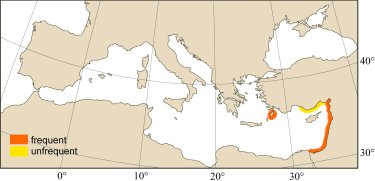
|
Relevant synonyms
Misidentification
Meristic formula
|
|
| photo : David Darom |
|
SHORT
DESCRIPTION
color :
brownish-fawn body with lateral series of dark brown to black blotches and dots. First dorsal of males black, only a black dot in females.
size :
common 5-10 cm (max. 18 cm). |
DISTINGUISHING CHARACTERISTICS
BIOLOGY / ECOLOGY
habitat :
benthic. Sandy and muddy substrate to 100 m. |
|
1st
MEDITERRANEAN RECORD
|

|
|
DISTRIBUTION
|
ESTABLISHMENT SUCCESS
speculated reasons for success :
|
|
|
MODE OF
INTRODUCTION |
IMPORTANCE TO
HUMANS |
|
KEY
REFERENCES
|
 Callionymus cf. brunneus
Callionymus cf. brunneus